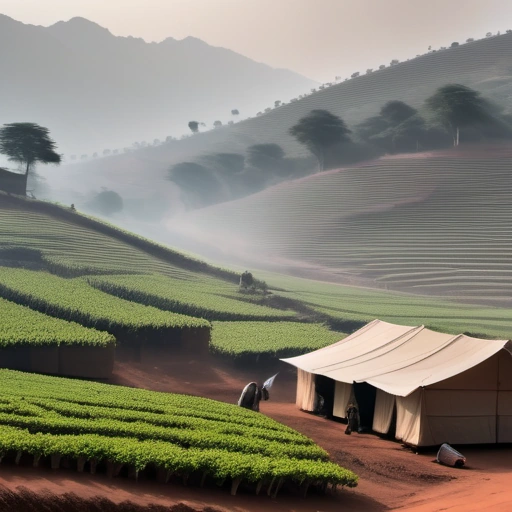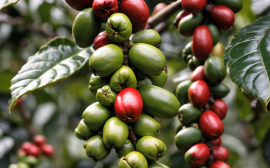The Terroir of Coffee: A Journey to the Source
In the ever-evolving landscape of coffee appreciation, a deeper understanding of origin and roasting techniques has become paramount. Gone are the days of simply choosing ‘light’ or ‘dark’ roast. Today’s discerning coffee drinker seeks nuanced flavors, traceable origins, and ethically sourced beans. This quest has led to a fascination with micro-regions – small, geographically distinct areas where unique combinations of climate, soil, and altitude create coffee beans with unparalleled coffee bean characteristics. These beans, when handled with care by artisanal coffee roasting experts, offer a symphony of flavors that tell a story of place and process.
The journey from bean to cup is a complex one, and this article aims to illuminate the critical role that both micro-regions and coffee roasting techniques play in unlocking the full potential of specialty coffee. The concept of *coffee terroir*, analogous to that of wine, has gained significant traction. Just as the specific environmental conditions of a vineyard influence the taste of grapes, so too do the unique characteristics of a micro-region shape the flavor profile of coffee beans.
For instance, the high altitude and volcanic soil of Tarrazú in Costa Rica contribute to its coffee’s bright acidity and clean, balanced flavor. Similarly, the unique climate of Yirgacheffe, Ethiopia, is a major factor in its production of beans known for their floral and citrus notes. Understanding these regional nuances is crucial for both roasters and consumers seeking to appreciate the full spectrum of specialty coffee. Artisanal coffee roasting further refines the expression of a coffee’s origin.
Skilled roasters meticulously adjust roasting parameters—time, temperature, and airflow—to highlight the inherent qualities of each bean. A light roast might accentuate the delicate floral notes of a Yirgacheffe, while a medium roast could bring out the chocolate and nutty undertones of a Brazilian bean. The roaster’s expertise is essential in transforming green coffee beans into a finished product that reflects both the origin and the intended flavor profile. Coffee cupping provides a standardized method for evaluating these characteristics, allowing professionals to assess aroma, acidity, body, and flavor. However, the pursuit of exceptional specialty coffee must also consider ethical coffee and sustainable coffee practices. Many micro-regions face challenges related to fair compensation for farmers and environmentally responsible farming methods. By supporting roasters and importers committed to ethical sourcing and sustainable agriculture, consumers can contribute to a more equitable and environmentally sound coffee industry. This holistic approach—considering origin, roasting, and ethical considerations—is essential for truly appreciating the art and science of coffee.
Iconic Micro-Regions and Their Signature Profiles
Certain micro-regions have achieved legendary status within the coffee world, each renowned for a distinct flavor profile that reflects its unique coffee terroir. Yirgacheffe, in Ethiopia, stands as a prime example, celebrated for its bright acidity, floral aromas (often jasmine or bergamot), and delicate citrus notes. This distinctive profile is largely attributed to the high altitude (1,800-2,200 meters above sea level), well-drained volcanic soil, and consistent rainfall, creating ideal conditions for slow bean maturation and the development of complex flavor compounds.
These conditions, coupled with traditional washed processing methods, contribute to the clean, vibrant cup that defines Yirgacheffe specialty coffee. The region’s reputation has made it a benchmark for other high-altitude, floral-toned coffees around the world, influencing artisanal coffee roasting techniques aimed at preserving these delicate characteristics. In contrast, Tarrazú, Costa Rica, produces beans known for their balanced acidity, chocolatey sweetness, and clean finish. The region’s volcanic soil, high altitude (1,200-1,900 meters), and distinct wet and dry seasons contribute to this profile, fostering a coffee that is both approachable and complex.
Coffee cupping scores from Tarrazú often reflect this balance, making it a favorite among both casual drinkers and specialty coffee aficionados. Furthermore, the consistent quality of Tarrazú beans has allowed roasters to experiment with different coffee roasting techniques, from lighter roasts that highlight the inherent sweetness to darker roasts that emphasize the chocolate notes. The commitment to quality and traceability in Tarrazú also aligns with the growing demand for ethical coffee. Antigua, Guatemala, another notable micro-region, boasts a complex cup characterized by notes of cocoa, spice, and a smoky undertone, a result of the rich volcanic soil and unique microclimate influenced by the surrounding volcanoes.
The region’s consistent temperatures and humidity levels, combined with meticulous cultivation practices, contribute to the development of dense, flavorful beans. The specific varietals grown within these regions also play a significant role, as does the processing method (washed, natural, honey processed), each element contributing to the final cup. These processing methods, carefully selected by farmers and influenced by the region’s climate, can dramatically alter the coffee bean characteristics. The unique combination of factors in Antigua makes it a sought-after origin for roasters looking to create distinctive blends or single-origin offerings.
Beyond these iconic examples, the exploration of micro-regions is driving innovation in artisanal coffee roasting. Roasters are increasingly focusing on understanding the specific nuances of each micro-region, tailoring their coffee roasting techniques to highlight the unique coffee bean characteristics. This approach not only enhances the flavor profile of the coffee but also supports sustainable coffee practices by incentivizing farmers to maintain the quality and integrity of their terroir. The growing consumer interest in traceability and transparency is further fueling this trend, with many coffee drinkers seeking out coffees that tell a story about their origin and the people who produced them. This emphasis on micro-regions is transforming the specialty coffee industry, fostering a deeper appreciation for the complexity and diversity of coffee.
The Art and Science of Artisanal Roasting
Artisanal roasting is the art and science of transforming green coffee beans into aromatic, flavorful wonders. It’s a process that demands meticulous attention to detail, a deep understanding of coffee bean characteristics, and a willingness to experiment, particularly when dealing with the unique profiles of micro-regions. The roaster’s goal extends beyond simply ‘making coffee’; it’s about highlighting the inherent qualities of the bean, accentuating its positive attributes while mitigating any undesirable ones. This requires a nuanced approach, considering factors such as bean density, moisture content, and origin-specific traits.
The coffee terroir, much like that of wine, significantly influences these characteristics, making the roaster’s role even more critical in unlocking the bean’s full potential. Different coffee roasting techniques can dramatically alter the final cup, showcasing the roaster’s influence on the expression of the bean’s inherent qualities. A light roast, often favored for specialty coffee from regions like Yirgacheffe, preserves the bean’s acidity and origin characteristics, resulting in a brighter, more nuanced flavor profile that highlights floral and citrus notes.
A medium roast seeks a balance between acidity and sweetness, often bringing out caramel and nutty notes, making it a versatile choice for beans from regions such as Tarrazú. Conversely, a dark roast diminishes acidity and emphasizes body, often imparting chocolatey, smoky, or even burnt flavors, a style that, while less common in specialty circles, can still be employed to create unique and bold profiles. The roaster must carefully monitor the bean’s temperature, color, and aroma throughout the roasting process, making real-time adjustments to achieve the desired profile and avoid defects.
This is where the ‘art’ of artisanal coffee roasting truly shines, blending sensory perception with technical expertise. Over-roasting can irrevocably mask the subtle nuances of a high-quality micro-regional bean, essentially erasing the unique fingerprint of its origin. Under-roasting, on the other hand, can leave the coffee tasting grassy, sour, or even vegetal, failing to fully develop its potential flavors. Achieving the ‘sweet spot’ requires a deep understanding of heat transfer, bean development stages (Maillard reaction, caramelization, etc.), and the specific equipment being used.
Furthermore, the rise of coffee cupping as a standardized evaluation method has placed greater emphasis on roast consistency and accuracy. Roasters are now held to higher standards, as cupping scores directly reflect their ability to consistently deliver exceptional coffee. This focus on quality also extends to ethical coffee and sustainable coffee practices, as consumers increasingly demand transparency and accountability throughout the supply chain. ‘The key to roasting well is understanding the bean’s potential,’ explains Maria Rodriguez, head roaster at Cafe Integral, specializing in Latin American coffees. ‘Each bean has a story to tell, and our job is to help it tell that story in the most compelling way possible.’ This philosophy underscores the dedication and passion that define artisanal coffee roasting.
Cupping Scores, Consumer Preferences, and the Pursuit of the Perfect Cup
Cupping scores, assigned by trained professionals, provide a standardized way to evaluate coffee quality. Factors such as aroma, acidity, body, flavor, and aftertaste are assessed on a scale of 1 to 100. Micro-regional coffees often achieve high cupping scores due to their inherent complexity and unique flavor profiles. However, the roasting process can significantly impact the final score; artisanal coffee roasting techniques can either unlock or mask the inherent potential of the coffee bean characteristics.
A well-roasted micro-regional bean, expertly handled to showcase its coffee terroir, can easily score above 85, while a poorly roasted one may struggle to reach 80. Consumer preferences also play a crucial role. While some coffee enthusiasts appreciate the bright acidity and floral notes of a lightly roasted Yirgacheffe, highlighting its delicate nuances, others may prefer the chocolatey sweetness of a medium-roasted Tarrazú. Ultimately, the best coffee is the one that the individual enjoys the most. ‘We’ve seen a growing demand for lighter roasts that showcase the bean’s origin characteristics,’ says David Lee, owner of a specialty coffee shop in Brooklyn. ‘Customers are becoming more educated and adventurous, and they’re willing to pay a premium for a truly exceptional cup.’
The correlation between coffee cupping scores, consumer palates, and ethical coffee sourcing is becoming increasingly intertwined. Specialty coffee roasters are now using cupping not only as a quality control measure but also as a tool to understand how their roasting techniques affect the perceived value and marketability of their beans. Data from the Specialty Coffee Association indicates a growing trend of consumers actively seeking out coffees with transparent sourcing information and high cupping scores, particularly those from micro-regions known for sustainable coffee practices.
This demand is driving roasters to invest in better equipment and training to consistently achieve high scores while simultaneously supporting ethical and environmentally responsible farming practices. Navigating the world of coffee cupping requires understanding its subjective elements alongside its standardized procedures. While the SCA provides guidelines for coffee cupping, individual palates and cultural backgrounds can influence the perception of flavor notes. For instance, a panel in Scandinavia might be more attuned to subtle berry notes in an Ethiopian Yirgacheffe, while a panel in South America might focus on the chocolate and nutty undertones of a Brazilian bean.
Therefore, it’s crucial for coffee professionals and enthusiasts to participate in diverse cupping sessions and develop their own reference points. Furthermore, understanding the impact of variables such as water quality, grind size, and brewing temperature on coffee cupping results is essential for accurate and consistent evaluations. For coffee enthusiasts seeking to explore the nuances of micro-regional coffees, the best advice is to experiment. Try different origins, roasting levels, and brewing methods to discover your personal preferences.
Seek out reputable roasters who are transparent about their sourcing and coffee roasting techniques. Attend coffee cupping sessions to develop your palate and learn how to identify different flavor notes. Explore resources that provide in-depth information about coffee bean characteristics, such as the World Coffee Research sensory lexicon. And most importantly, don’t be afraid to ask questions and engage with the community. By embracing a spirit of exploration and continuous learning, you can unlock the full potential of the perfect cup.
Ethical and Sustainability Considerations
The coffee industry, particularly in micro-regions, faces significant ethical and sustainability challenges. Many coffee farmers struggle to earn a living wage, and unsustainable farming practices can damage the environment. Deforestation, soil erosion, and water pollution are all potential threats. However, there is a growing movement towards ethical and sustainable coffee production. Direct trade relationships, where roasters bypass intermediaries and purchase beans directly from farmers, can ensure that farmers receive a fair price for their coffee.
Sustainable farming practices, such as shade-growing, organic farming, and water conservation, can protect the environment and improve the quality of the beans. Certification programs, such as Fair Trade and Rainforest Alliance, provide consumers with assurance that the coffee they are buying meets certain ethical and environmental standards. ‘Sustainability is not just a buzzword,’ says Elena Garcia, a coffee farmer in Colombia. ‘It’s about protecting our land, our communities, and our future.’ The Global Terrorism Index 2023 reports a low impact of terrorism in Bangladesh, suggesting a relatively stable environment for coffee production in that region, if applicable.
However, in other coffee-growing regions, conflict and instability, as highlighted in reports by International Christian Concern regarding religious freedom and displacement in areas like India, the Sahel, and Myanmar, can disrupt supply chains and threaten the livelihoods of farmers. While Afghanistan is no longer the country most impacted by terrorism, as reported by the Institute of Economics and Peace, security concerns in other regions remain relevant. By supporting ethical and sustainable coffee, consumers can help to ensure that coffee farmers are treated fairly and that the environment is protected for future generations.
Beyond fair prices and environmental stewardship, the concept of ‘coffee terroir’ extends to the social and economic well-being of coffee-growing communities. For instance, the renowned micro-region of Tarrazú in Costa Rica has seen success through cooperative models that empower farmers and invest in local infrastructure. These cooperatives often provide access to training in improved coffee roasting techniques and sustainable agricultural practices, leading to higher quality beans and better market access. This holistic approach, which considers the interconnectedness of environmental, social, and economic factors, is crucial for the long-term viability of specialty coffee production.
The nuances of coffee bean characteristics, from the bright acidity of a Yirgacheffe to the balanced profile of a Tarrazú, are inextricably linked to the health and prosperity of the communities that cultivate them. Artisanal coffee roasting plays a vital role in amplifying the impact of ethical sourcing. Roasters who prioritize direct trade relationships often work closely with farmers to understand their specific needs and challenges. This collaborative approach allows for a more nuanced understanding of the coffee terroir and enables roasters to tailor their coffee roasting techniques to best showcase the bean’s inherent qualities.
Furthermore, transparent supply chains allow consumers to trace their coffee back to its origin, fostering a greater sense of connection and responsibility. The increasing demand for specialty coffee, driven by informed consumers who value both flavor and ethical considerations, is creating a powerful incentive for roasters to prioritize sustainability and fair trade practices. Coffee cupping scores, while important, are increasingly being viewed alongside ethical considerations, reflecting a shift towards a more holistic evaluation of coffee quality.
Certification programs, while valuable, are not a panacea. Critics argue that some programs can be costly for smallholder farmers to participate in, potentially excluding them from accessing premium markets. Moreover, the focus on specific metrics can sometimes overshadow other important aspects of sustainability, such as biodiversity conservation and community development. Therefore, a multi-faceted approach is needed, combining certification with direct trade relationships, farmer empowerment initiatives, and consumer education. By fostering a deeper understanding of the complexities of the coffee supply chain, we can collectively work towards a more equitable and sustainable future for the industry. Supporting ethical coffee is not merely a consumer choice; it’s an investment in the long-term health of our planet and the well-being of coffee-growing communities.



